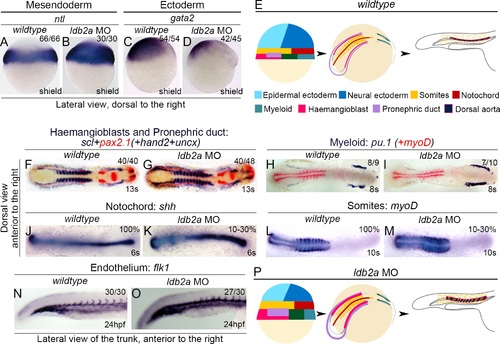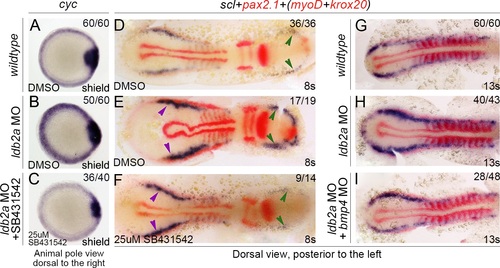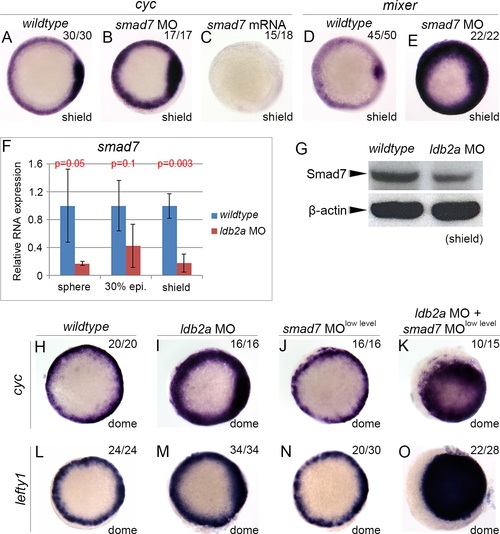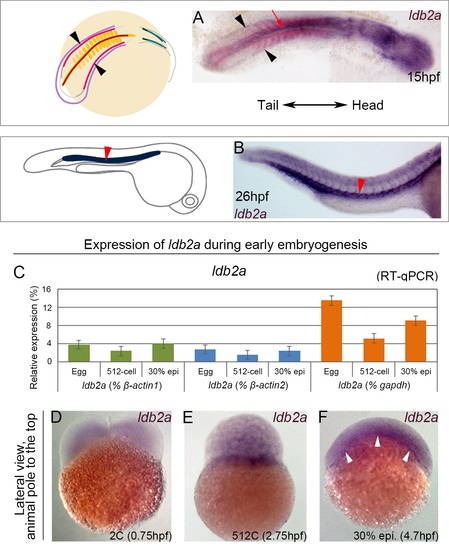- Title
-
A Novel TGFβ Modulator that Uncouples R-Smad/I-Smad-Mediated Negative Feedback from R-Smad/Ligand-Driven Positive Feedback
- Authors
- Gu, W., Monteiro, R., Zuo, J., Simões, F.C., Martella, A., Andrieu-Soler, C., Grosveld, F., Sauka-Spengler, T., Patient, R.
- Source
- Full text @ PLoS Biol.
|
Knockdown of ldb2a enhances Nodal/BMP signal transduction in zebrafish embryos. (A) At the onset of gastrulation, ldb2a expression is more noticeable in the yolk syncytial layer (YSL) (white arrowheads), which is an important source of Nodal signals (purple arrows). (B) At the shield stage, western blot showed increased phosphorylation of R-Smad2 in ldb2a morphants, while the level of overall Smad2/3 remained the same. β-actin was used as a loading control. (C) The activity of a TGFβ reporter SBE-luciferase was up-regulated in shield stage ldb2a morphants. (D) Phosphorylation of R-Smad1/5/8 was up-regulated in ldb2a morphants at the tailbud stage. β-tubulin was the loading control. (E) The activity of a BMP reporter Id1-BRE2-luciferase was increased in tailbud stage ldb2a morphants. (C and E) each displays a single representative experiment of three biological replicates, with the error bars corresponding to two technical replicates. For each biological replicate, 50 embryos were lysed and analysed. (F-I′) Expression of Nodal ligands, cyc and sqt, was increased in shield stage ldb2a morphants. (J-K′) Anterior and posterior expression of bmp4 was up-regulated at the tailbud stage. (F-G′): seven independent experiments, with the total number of analysed embryos shown on the top-right corner of each panel; (H-K′): two independent experiments. The wildtype control refers to uninjected embryos that are stage matched. |
|
Ldb2a knockdown promotes the specification of mesendoderm and mesoderm. (A–B) In ldb2a morphants, ntl expression in the mesendoderm/mesoderm was expanded into the ectoderm. (C–D) The ectoderm was restricted (decreased gata2 expression). (E) Gastrula ventral or dorsal mesendoderm develops into haemangioblast/pronephric or myeloid populations respectively, during somitogenesis, while the mesoderm becomes somites and notochord. (F–I) During somitogenesis, expression of scl, pax2.1, hand2, and pu.1 in the lateral mesoderm was up-regulated in ldb2a morphants. Embryos were co-stained with uncx or myoD to define the stage. (J–M) Other mesendoderm and mesoderm derivatives were also increased including somite (myoD) and notochord (shh), although only in a proportion of most affected morphants. (N–O) At 24 hpf, ldb2a knockdown caused increased expression of an endothelial gene, flk1, in the vessels (lateral mesoderm-derived). (P) As a summary, the loss of ldb2a expression induces mesodermal and endodermal while restricting ectodermal fates, especially in the ventro-lateral and posterior regions, and this fate change is stable. (A–D): three independent experiments, with the total number of analysed embryos shown in each panel; (F–G): five independent experiments; (H–I): one experiment; (J–O): three independent experiments. The wildtype control refers to uninjected embryos that are stage matched. |
|
The roles of Ldb2a in the specification of mesendoderm and derivatives depend on Nodal and BMP signalling. (A–C) SB431542 rescued the increased expression of cyc caused by ldb2a knockdown. (D–F) SB431542 also partially rescued the increase in expression of lateral mesodermal genes, scl and pax2.1, in ldb2a morphants (green and purple arrowheads). The wildtype control refers to uninjected embryos that are stage matched and treated with equal volume of DMSO. (G–I) Co-injection with a bmp4 MO partially rescued the increased scl expression in ldb2a morphants. Embryos co-stained with myoD and krox20 to define the stage and territory. (A–C): three independent experiments (the morphant phenotype of cyc expression was observed from seven independent experiments, whereas the rescue experiments were repeated three times); (D–F): two independent experiments; (G–I): three independent experiments. The wildtype control refers to uninjected embryos that are stage matched. EXPRESSION / LABELING:
|
|
Ldb2a and Smad7 function in the same pathway. Knockdown of smad7 increased expression of Nodal target genes, cyc (A–B) and mixer (D–E), whereas overexpression of smad7 mRNA abolished cyc expression (C). In (A–E), one experiment was performed, with the total number of analysed embryos indicated in each panel. These are mainly confirming results published already [39]. (F) Smad7 mRNA level decreased in ldb2a morphants from the sphere stage, shown by RT-qPCR. Error bars are drawn from three independent experiments, each with three technical replicates. (G) Western blot showed decreased protein levels of Smad7 in shield stage ldb2a morphants. β-actin was the loading control. (H–O) Co-injection of ldb2a MO with low-level smad7 MO that did not cause any defect on its own resulted in ectopic expression of Nodal targets, cyc and lefty1, in the ectoderm, suggesting a synergistic effect between ldb2a and smad7 MOs. Experiments were repeated twice, with the total number of analysed embryos indicated in each panel. The wildtype control refers to uninjected embryos that are stage matched. |
|
Zebrafish ldb2a expression. (A) During mid-late somitogenesis, ldb2a is present in the notochord (red arrows) and the PLM (black arrowheads). Embryos were co-stained with myoD to define the stage. (B) After somitogenesis, ldb2a expression becomes more specific in blood vessels (red arrowhead). Maternal/zygotic ldb2a is ubiquitously expressed in cleavage- and blastula-stage embryos, shown by RT-qPCR analysis (C) and whole-mount in situ hybridisation (D–F). RT-qPCR primers are separated by the exon-exon boundary on the 3′ end, to reduce the genomic background. |





